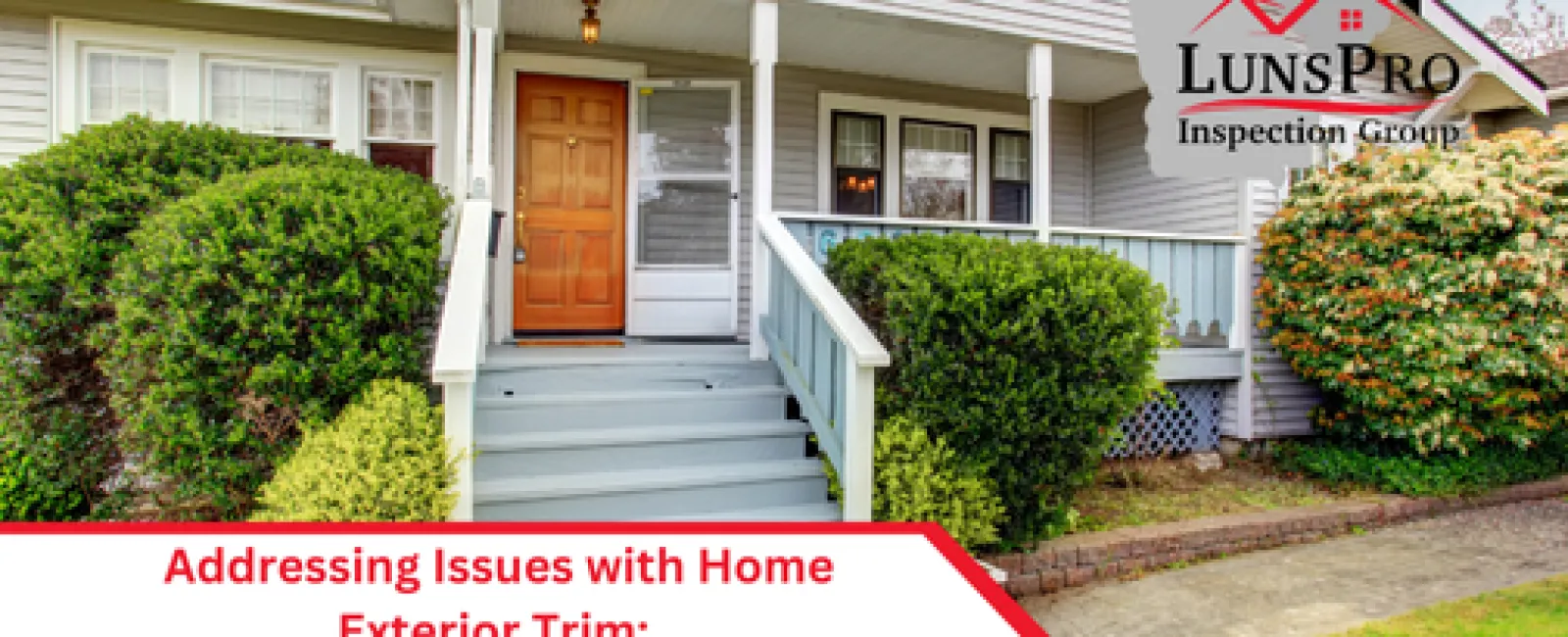The exterior trim of a home serves as a crucial barrier, protecting it from the elements while enhancing its curb appeal. Over time, however, wear and tear can compromise this important feature, leading to both cosmetic and structural issues. Whether you're a homeowner or a potential buyer, understanding the significance of exterior trim maintenance is essential for preserving the integrity and aesthetics of a property. At LunsPro Inspection Group, we emphasize the importance of proactive care and accurate assessments to make informed decisions about repairs or replacements.
This comprehensive guide will delve into identifying common issues with exterior trim, exploring repair versus replacement options, and highlighting how professional Carolina residential and commercial inspections can ensure your home remains in top condition.
Understanding Exterior Trim and Its Importance
Exterior trim refers to the decorative and functional components framing doors, windows, and corners, as well as fascia boards, soffits, and other structural accents. Typically constructed from wood, fiber cement, or PVC, trim not only adds architectural detail but also protects the vulnerable edges of siding and roofing.
Without proper maintenance, damaged trim can lead to:
- Water Damage: Compromised trim allows water to infiltrate, causing rot and mold growth.
- Pest Infestations: Cracked or rotting wood provides easy entry points for termites, carpenter ants, and other pests.
- Decreased Energy Efficiency: Poorly sealed trim can lead to drafts, increasing heating and cooling costs.
- Reduced Curb Appeal: Worn or deteriorating trim significantly diminishes a home's aesthetic appeal.
Regularly inspecting and addressing trim issues is key to maintaining a property's value and functionality.
Common Issues with Home Exterior Trim
During Carolina home inspections, some of the most common problems we encounter with exterior trim include:
Rot and Decay
Wood trim, particularly in older homes, is highly susceptible to moisture damage. Signs of rot include soft, spongy areas, discoloration, or visible mold.Cracks and Splitting
Changes in temperature and humidity can cause trim to expand and contract, leading to splits and cracks over time.Peeling Paint or Fading Finishes
Exposure to sunlight and moisture causes paint to peel or fade, leaving the underlying material exposed to further damage.Warping or Buckling
Poor installation or prolonged exposure to moisture can cause trim to warp, impacting its fit and appearance.Pest Damage
Termites, carpenter ants, and other wood-boring insects often target untreated or decaying trim.
Each of these issues poses unique challenges, requiring a careful assessment to determine whether repair or replacement is the best course of action.
Repair vs. Replace: Factors to Consider
When dealing with damaged trim, the decision to repair or replace depends on several factors, including the extent of the damage, material type, and overall condition of the home. Let's explore these considerations in detail:
1. Extent of Damage
- Minor Damage: Small cracks, peeling paint, or localized rot can often be repaired. Applying a wood filler, sanding, and repainting are common solutions for superficial damage.
- Widespread Damage: When rot or decay affects large sections of trim, replacement may be more cost-effective and reliable.
2. Material Type
- Wood: While traditional and visually appealing, wood trim is prone to rot and requires regular maintenance. Repairs are feasible for isolated issues, but replacement with more durable alternatives may be a better long-term solution.
- Fiber Cement and PVC: These materials resist moisture and pests, making them more durable. Damaged sections may still need replacement, as repairs are often less effective.
3. Longevity and Maintenance
- If the trim requires frequent repairs due to age or poor-quality materials, replacement with a more durable option can reduce future maintenance costs.
4. Budget and Aesthetic Goals
- Repairing trim is usually less expensive upfront, but replacement offers a chance to update the home's style or improve its energy efficiency with modern materials.
5. Inspection Insights
A professional inspection from LunsPro Inspection Group can provide a detailed assessment, helping you weigh the benefits of repair versus replacement based on the specific needs of your home.
Steps for Repairing Exterior Trim
For homeowners opting to repair damaged trim, following these steps can ensure a lasting solution:
- Inspect Thoroughly: Identify all areas of damage, paying close attention to corners, seams, and areas near gutters or downspouts.
- Remove Damaged Material: Use a chisel or saw to cut away decayed or damaged sections.
- Apply Filler or Patch: Fill cracks or holes with epoxy wood filler or a similar material, smoothing it to match the surrounding surface.
- Sand and Prime: Sand the area to ensure a smooth finish, then apply a primer to seal the material.
- Paint or Stain: Use high-quality exterior paint or stain to protect the trim from future damage.
When Replacement Is Necessary
Replacement is often the best option for severely damaged or outdated trim. Here's what the process typically involves:
- Material Selection: Choose from durable materials like fiber cement, PVC, or treated wood to enhance longevity and performance.
- Removal of Old Trim: Carefully remove the old trim to avoid damaging the underlying structure.
- Installation of New Trim: Ensure the new trim is securely fastened and properly sealed to prevent water infiltration.
- Finishing Touches: Paint or stain the new trim to match the home's exterior.
The Role of Professional Inspections
Scheduling regular Carolina residential and commercial inspections can help homeowners identify trim issues early, preventing costly repairs down the line. During inspections, professionals assess the condition of the exterior trim, siding, and other critical components, offering tailored recommendations to maintain your home's value and safety.
LunsPro Inspection Group specializes in providing detailed evaluations, ensuring homeowners in the Carolinas have the information needed to protect their investments. From spotting subtle signs of rot to recommending durable replacement materials, our team is committed to excellence.
Preventive Maintenance Tips
Preventive maintenance is key to extending the lifespan of your exterior trim. Follow these tips to keep it in excellent condition:
- Inspect Annually: Check for signs of rot, cracks, and peeling paint each year, especially after severe weather.
- Clean Regularly: Remove dirt, debris, and mildew with a gentle cleaner to prevent buildup.
- Seal and Paint: Reapply paint or sealant every few years to protect against moisture and UV damage.
- Repair Promptly: Address minor issues as soon as they arise to avoid further deterioration.
Protecting Your Home's Exterior
Exterior trim plays a vital role in safeguarding your home's structural integrity and enhancing its visual appeal. Addressing issues promptly, whether through repair or replacement, is essential for maintaining a safe, energy-efficient, and attractive property.
At LunsPro Inspection Group, we're dedicated to helping homeowners navigate these decisions with confidence. Through professional Carolina home inspections, we provide detailed insights into your home's condition, empowering you to make informed choices about repairs and replacements.
By investing in high-quality materials, professional assessments, and regular maintenance, you can ensure your home's exterior trim remains a durable and beautiful feature for years to come. Whether you're a current homeowner or considering a purchase, don't hesitate to reach out to our team for expert guidance and comprehensive inspections. Together, we'll protect your home's value and functionality, one detail at a time.

